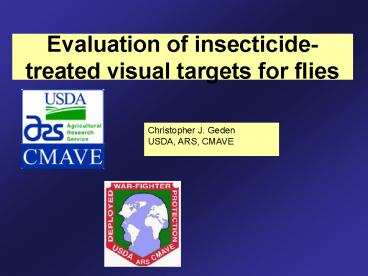Evaluation of insecticidetreated visual targets for flies - PowerPoint PPT Presentation
1 / 37
Title:
Evaluation of insecticidetreated visual targets for flies
Description:
In a previous study we found that house flies are also attracted to this shade ... Targets (blue fabric portion only) treated with 0.08% spinosad or 0.075 ... – PowerPoint PPT presentation
Number of Views:62
Avg rating:3.0/5.0
Title: Evaluation of insecticidetreated visual targets for flies
1
Evaluation of insecticide-treated visual targets
for flies
Christopher J. Geden USDA, ARS, CMAVE
2
Objective Develop an insecticide-treated visual
target to provide perimeter protection from filth
flies. Hypothesis Treated targets can be used
as attract-and-kill devices to intercept
migrating flies from source populations. Military
relevance Filth flies and their associated
pathogens pose troop health and combat-readiness
threats.
3
Vavoua
Biconical
Nzi
Epsilon
Ngu
Tsetse flies are attracted to blue fabric with
peak reflectance at 466nm.
4
- Blue targets are attractive to tsetse, Stomoxys
spp and some tabanids. Why? - Daytime shadows are blue tinged because of
scattered skylight. Shadows provide clues that
shelter and hosts may be nearby in open habitats
(Steverding and Troscianko 2004) - Sensitivity to blue may help zoophilic species
discover non-green objects in landscapes
dominated by vegetation.
5
In a previous study we found that house flies are
also attracted to this shade of blue, especially
when it is paired with clear Alsynite
fiberglass. We are now searching for toxicants to
apply to visual targets to develop an attract
and kill system for house flies.
6
- Bioassay
- Flies placed on filter paper on treated surface
covered with a petri dish bottom. - Papers removed for a set period of time.
- At end of exposure time, the paper is replaced
under the dish - Flies transferred to holding containers with
cotton balls soaked in 10 sucrose. Mortality
read at the end of the exposure and at 3 and 24
hours post-exposure.
7
At 3 hours, mortality of susceptible flies was
over 80 after brief exposures. Mortality of
wild flies never exceeded 32.
8
Label rate
9
- Cage study with treated targets
- Visual targets treated with 1.2 bifenthrin
(blue portion only) - 6000 flies released per tent.
- Flies provided with food and water
- Molasses lure placed inside half of the treated
targets - Flies monitored by Scudder grid counts on days
0, 2, and 4
10
(No Transcript)
11
Bifenthrin-treated targets controlled ca. 90 of
wild flies after 4 days.
12
Pyrethroids are unlikely to be effective for use
in the field because of resistance. Imidacloprid
and Spinosad may be more appropriate for this
application
13
2. Starved flies before paper placement
1. Treated papers drying
Filter papers with QuickBayt diluted in water
(first dilution), then 20 sucrose
4. At 1 hr, papers replaced with clean cards
3. Flies on treated papers
14
(No Transcript)
15
Wild flies were more tolerant of spinosad than
insecticide-susceptible flies
16
As was seen in contact assays, some evidence for
spinosad tolerance in wild flies
17
Spinosad was more effective when ingested than
when tested in contact-only assays
18
(No Transcript)
19
Targets (blue fabric portion only) treated with
0.08 spinosad or 0.075 imidacloprid in 20
sucrose and allowed to dry. For these tests, a
cotton poly blend was used instead of Sunbrella
because of Sunbrellas water-repellency.
Violet 400 nm
Blue 475 nm
Indigo 445 nm
Green 510 nm
Yellow 570 nm
Red 650 nm
20
In the previous tent trials we had used Scudder
grid counts. But grid counts were highly
variable. For this test, we tarped the floors
of the screen rooms, intending to collect and
count dead flies to measure mortality. But
21
(No Transcript)
22
Instead, visual counts were made of flies resting
on each of the 6 screen sides of the rooms
23
(No Transcript)
24
Fly counts on tent sides dropped after placement
of the targets, even in the controls, because of
fly visitation to targets.
25
After 1 month, imidacloprid-treated targets
killed 95 of the flies in 24 hrs.
Spinosad-treated targets had lost much of their
potency.
26
Comparison of commercial filth fly traps
Objective Assist Navy NECE personnel in
evaluating commercial fly traps in field
situations. Traps will be tested out of the
box with their respective attractants. Hypothesi
s Commercial products can be ranked in efficacy
for fly control. Military relevance At
present, the Monster, a.k.a. Flies Be Gone is
only trap with an NSN. Is this trap a good value
for troops and taxpayers?
27
Monster, a.k.a. Flies-be-gone
Squeeze n snap
28
Fermone Big Boy
Advantage
29
(No Transcript)
30
Oak Stump Fly Trap Dark, with small side
entry Designed for blow flies, but with new
bait is being marketed for house flies
ISCA fly trap Two attractants (top and
bottom) Bottom entry
31
Four farms. Traps placed either near calves or
by feed barn (2 farms each)
32
(No Transcript)
33
(No Transcript)
34
(No Transcript)
35
House fly collections
36
Blow fly collections
37
- Monster Flies-be-gone
- Ranked 3 (HF), 5 (BF)
- Moderate attractant
- Efficient trap geometry
- Inexpensive
- Single-use
- Farnam Terminator
- Most effective trap tested
- Excellent attractant
- Inefficient trap geometry
- More expensive
- Reusable































